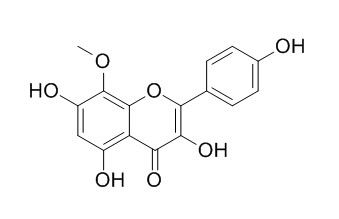8-Methoxykaempferol
Standard reference
Inquire / Order:
manager@chemfaces.com
Technical Inquiries:
service@chemfaces.com
Tel:
+86-27-84237783
Fax:
+86-27-84254680
Address:
1 Building, No. 83, CheCheng Rd., Wuhan Economic and Technological Development Zone, Wuhan, Hubei 430056, PRC
Providing storage is as stated on the product vial and the vial is kept tightly sealed, the product can be stored for up to
24 months(2-8C).
Wherever possible, you should prepare and use solutions on the same day. However, if you need to make up stock solutions in advance, we recommend that you store the solution as aliquots in tightly sealed vials at -20C. Generally, these will be useable for up to two weeks. Before use, and prior to opening the vial we recommend that you allow your product to equilibrate to room temperature for at least 1 hour.
Need more advice on solubility, usage and handling? Please email to: service@chemfaces.com
The packaging of the product may have turned upside down during transportation, resulting in the natural compounds adhering to the neck or cap of the vial. take the vial out of its packaging and gently shake to let the compounds fall to the bottom of the vial. for liquid products, centrifuge at 200-500 RPM to gather the liquid at the bottom of the vial. try to avoid loss or contamination during handling.
J. Soc. Cosmet. Sci. Korea2016, 163-171
Plant Cell, Tissue and Organ Culture (PCTOC)2024, 158:54
Nutrients.2018, 10(10)
Nutrients2023, 15(18), 4016.
Nutrients.2021, 13(3):978.
Toxicol In Vitro.2018, 52:94-105
Int Immunopharmacol.2022, 106:108603.
J AOAC Int.2024, qsae028.
Metabolites.2020, 11(1):E11.
Oxid Med Cell Longev.2022, 2022:5888636.
Related and Featured Products
J Chromatogr A. 2009 Oct 23;1216(43):7241-8.
Liquid chromatography-tandem mass spectrometry reveals the widespread occurrence of flavonoid glycosides in honey, and their potential as floral origin markers.[Pubmed:
19683245]
METHODS AND RESULTS:
Rhamnosyl-hexosides (tentatively rutinosides and neohesperidosides) and dihexosides (hexosyl(1-->2)hexosides and hexosyl(1-->6)hexosides) of flavonols such as quercetin, kaempferol, isorhamnetin and 8-Methoxykaempferol, are the main flavonoid glycosides found in honey. However, flavonoid triglycosides and monoglycosides are also detected in some floral origins.



